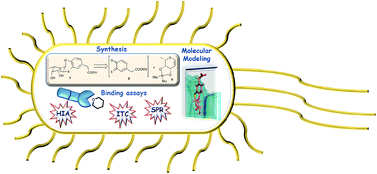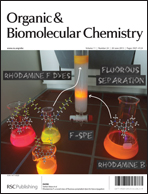Burkholderia ambifaria is a bacterium member of the Burkholderia cepacia complex (BCC), a closely related group of Gram-negative bacteria responsible for “cepacia syndrome” in immunocompromised patients. B. ambifaria produces BambL, a fucose-binding lectin that displays fine specificity to human fucosylated epitopes. Here, we report the first example of a synthetic ligand able to selectively bind, in the micromolar range, the pathogen-lectin BambL. The synthetic routes for the preparation of the α conformationally constrained fucoside are described, focusing on a totally diastereoselective inverse electron demand [4 + 2] Diels–Alder reaction. Isothermal titration calorimetry (ITC) demonstrated that this compound binds to the pathogen-associated lectin BambL with an affinity comparable to that of natural fucose-containing oligosaccharides. No binding was observed by LecB, a fucose-binding lectin from Pseudomonas aeruginosa, and the differences in affinity between the two lectins could be rationalized by modeling. Furthermore, SPR analyses showed that this fucomimetic does not bind to the human fucose-binding lectin DC-SIGN, thus supporting the selective binding profile towards B. ambifaria lectin.

You have access to this article
 Please wait while we load your content...
Something went wrong. Try again?
Please wait while we load your content...
Something went wrong. Try again?


 Please wait while we load your content...
Please wait while we load your content...